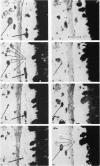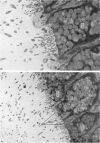Abstract
1. Electrophysiological study disclosed that chloroform and some other odours generate long-lasting positive potentials in the olfactory epithelium of the bullfrog, while electron microscopical study showed that they elicit vigorous protrusion of the distal cytoplasmic portion of the supporting cell containing the secretory granules.
2. The secretory process of the supporting cell is as follows: The first detectable indication is the protrusion of the apical portion of the supporting cell (Pls. 3 and 4); the protruded part detaches from its maternal supporting cell (Pl. 7 B), floats as a droplet in the mucus (Pl. 5), and finally the secretory granules inside the droplet disintegrate into the mucus (Pls. 6 and 7 A).
3. The secretion was not elicited by the odours which elicit the negative potentials.
4. In Cl--free Ringer solution, neither the positive potential nor the protrusion and secretion occurred.
5. When 1-2 mM-Ba2+ in Ringer solution was dripped on the epithelium, both the positive potential and the protrusion and secretion resulted. Subsequent application of chloroform vapour only advanced further disintegration of the secretory granules, but it elicited neither a new protrusion of the granules nor the positive potential.
6. In the olfactory epithelium in which the olfactory cells had degenerated but the supporting cells survived, both the positive potential and the protrusion and secretion occurred, but the negative potential did not.
7. It is concluded that Cl- entry which mainly generates the longlasting positive potential triggers the secretion of the supporting cell.
Full text
PDF
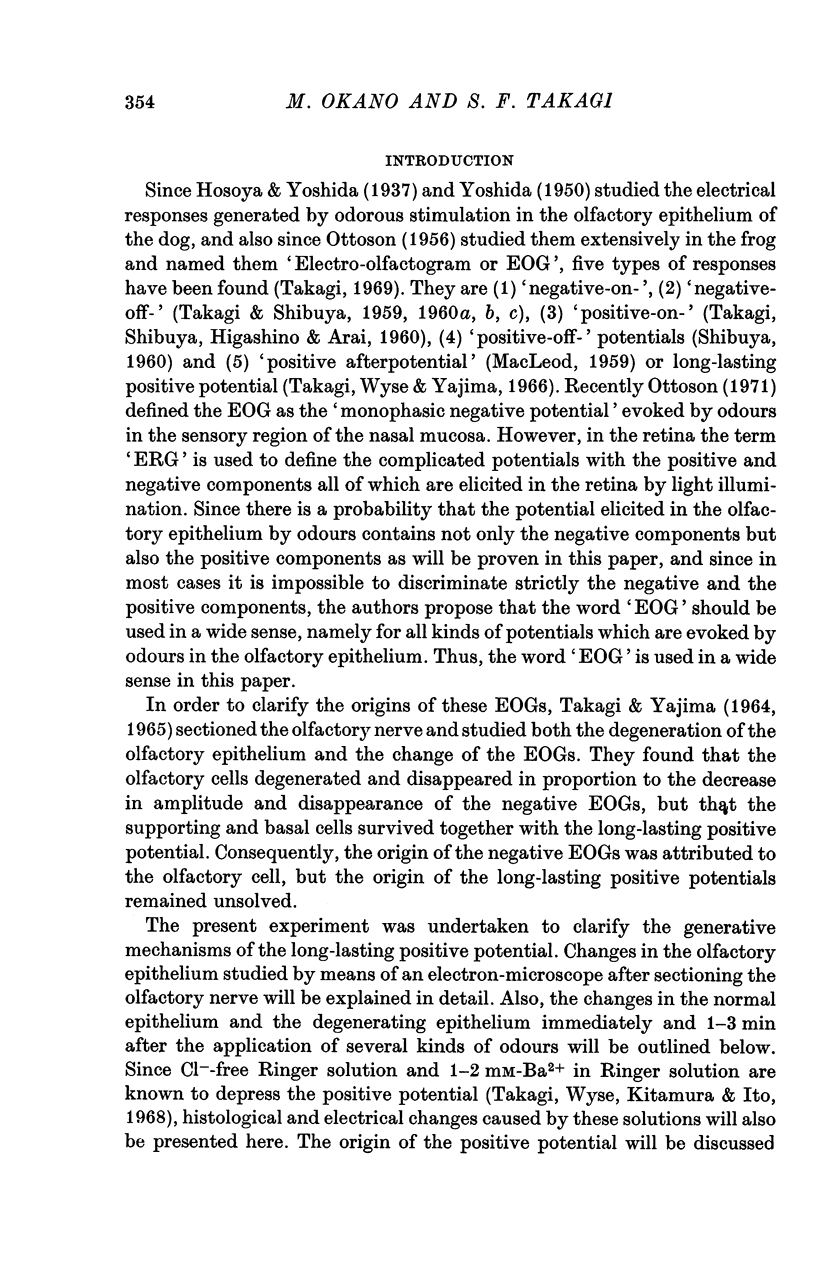


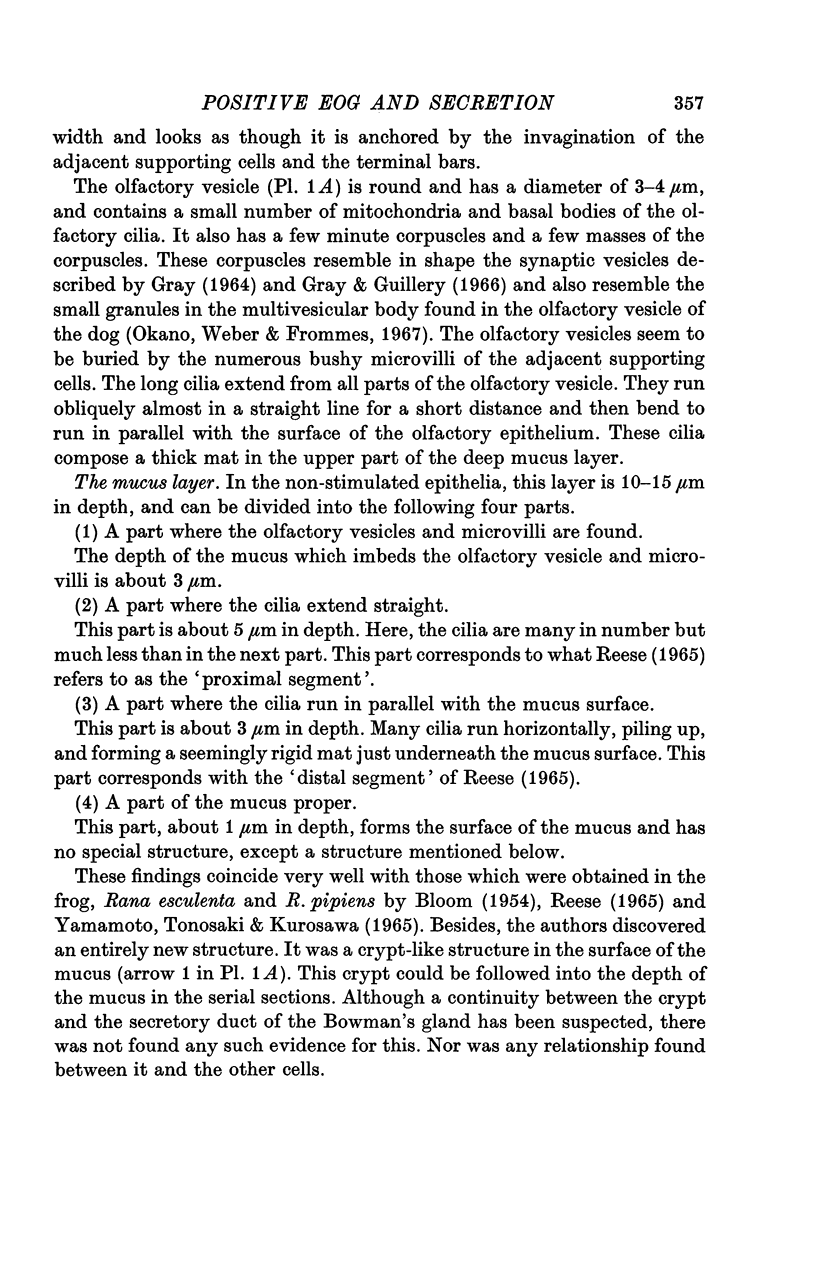

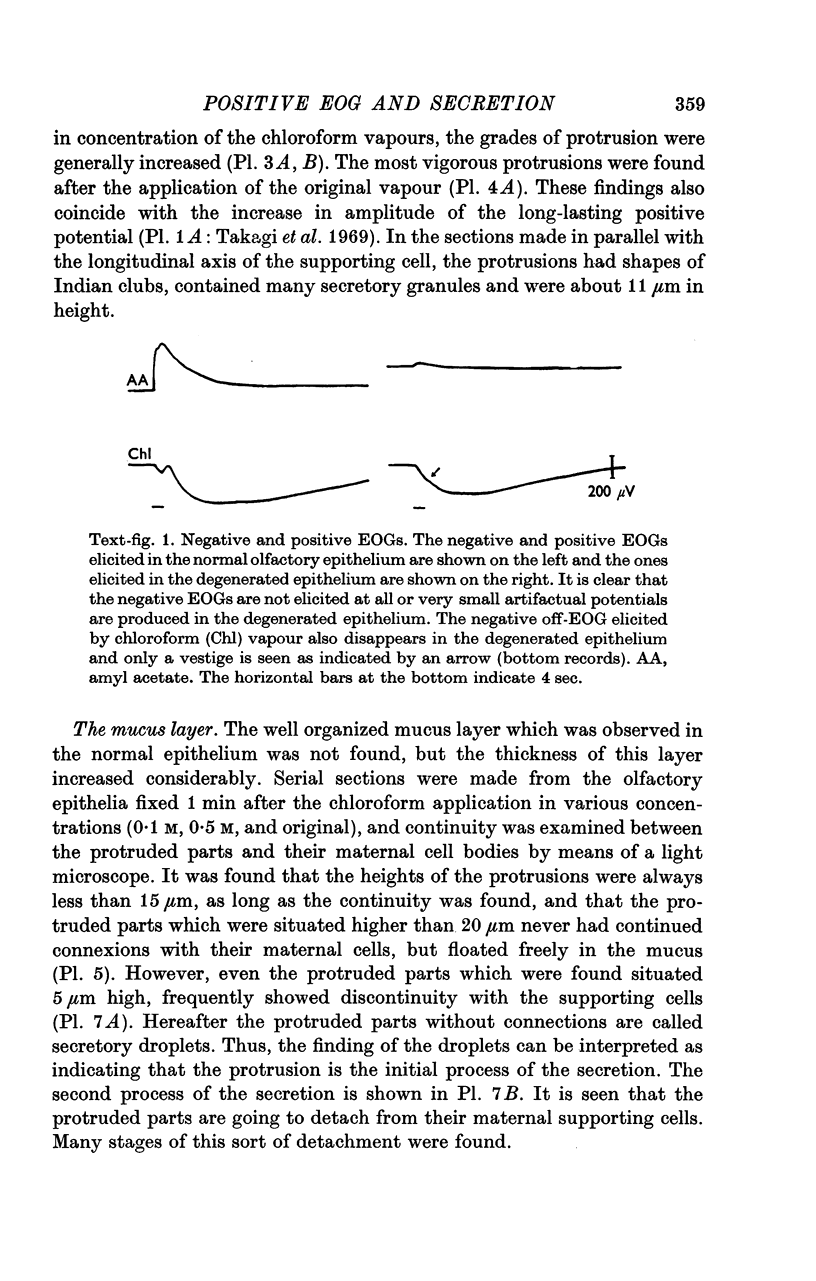

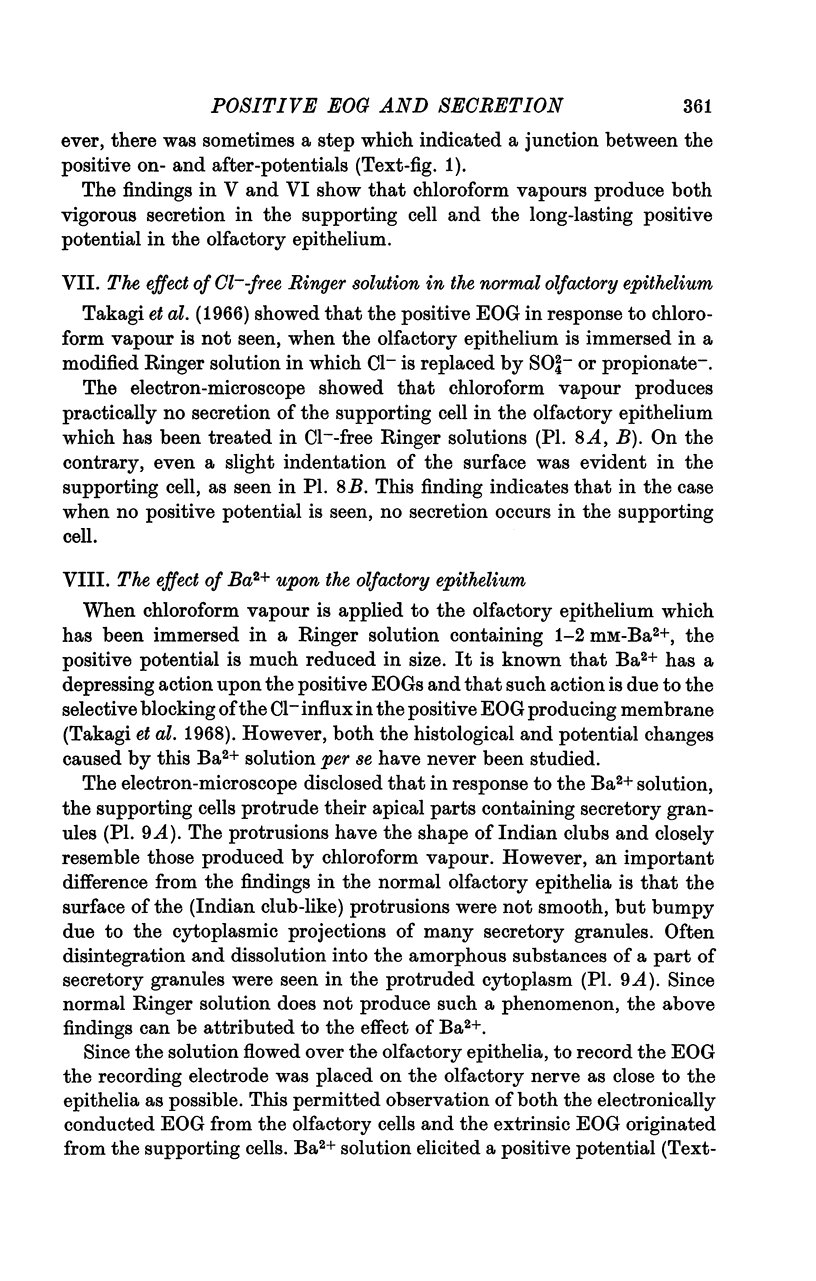

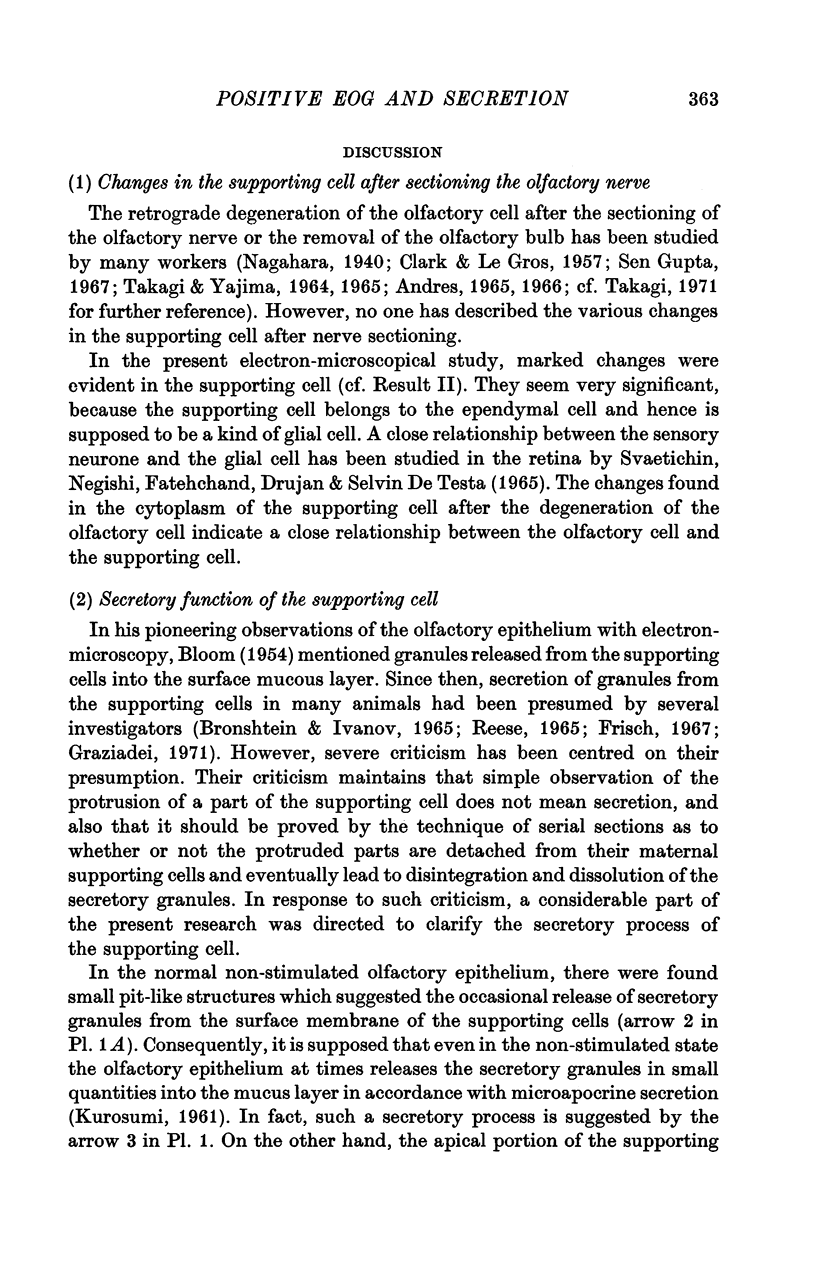
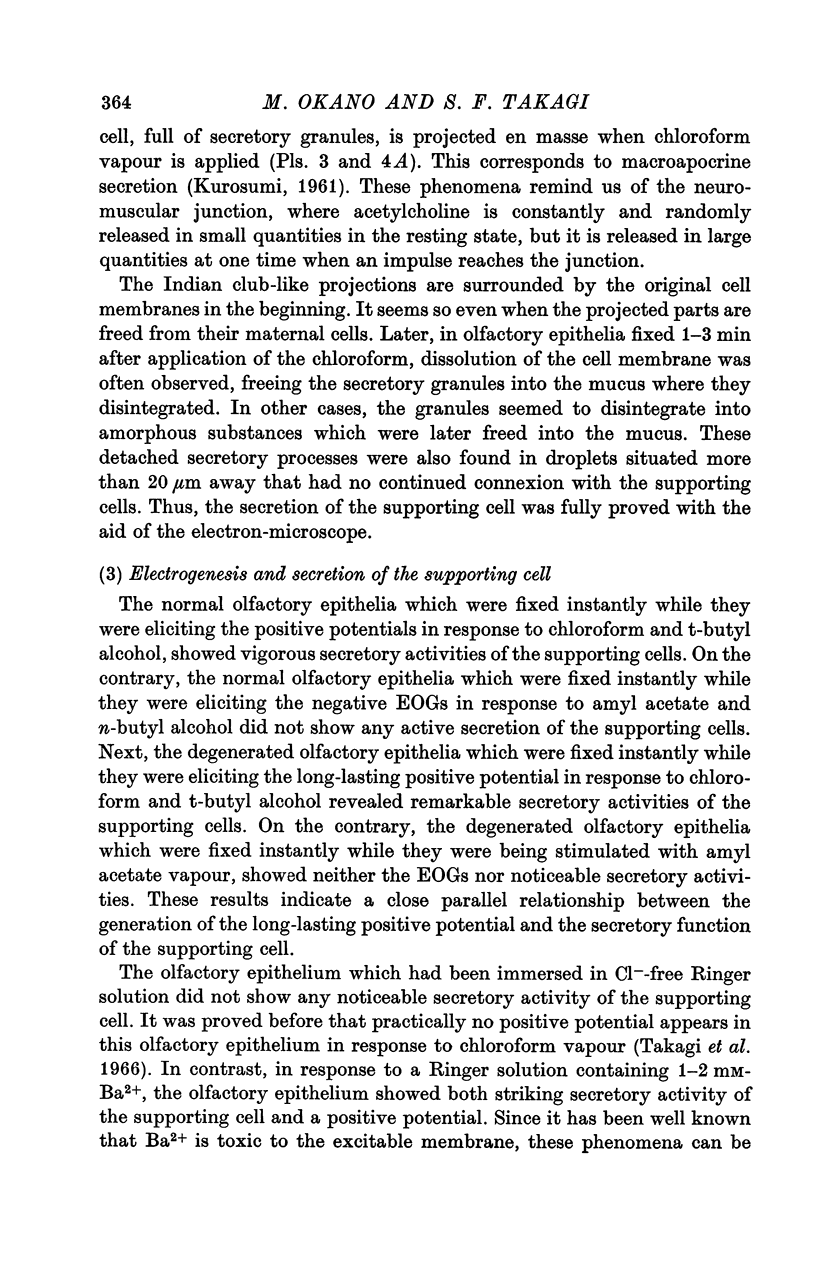
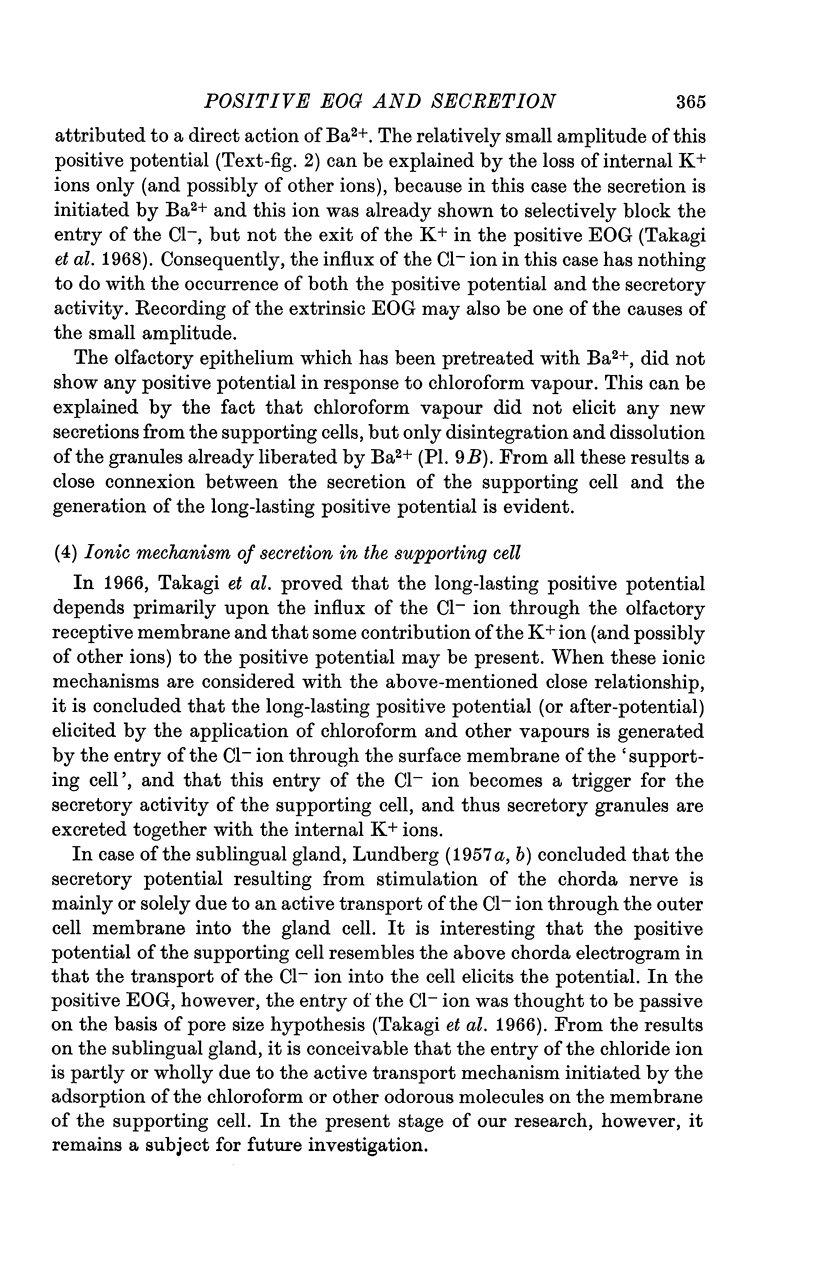
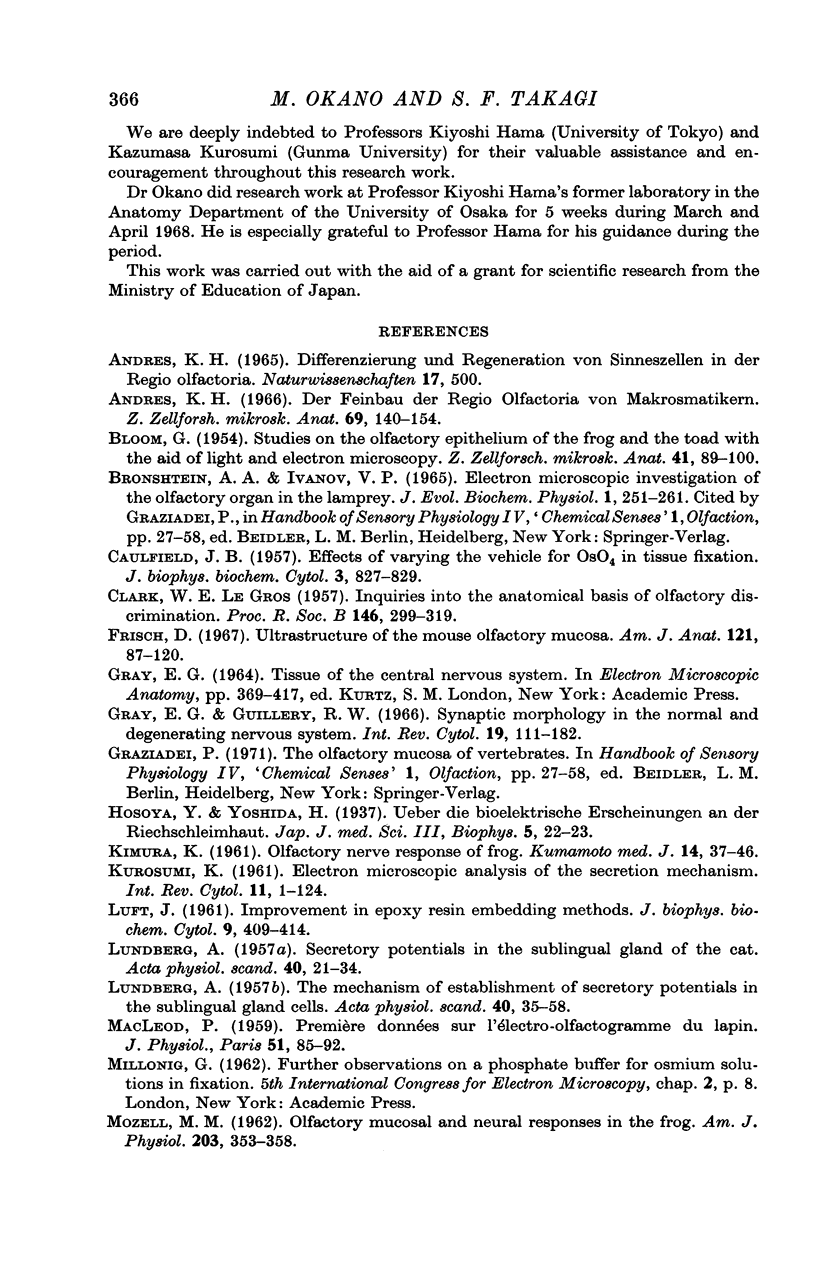

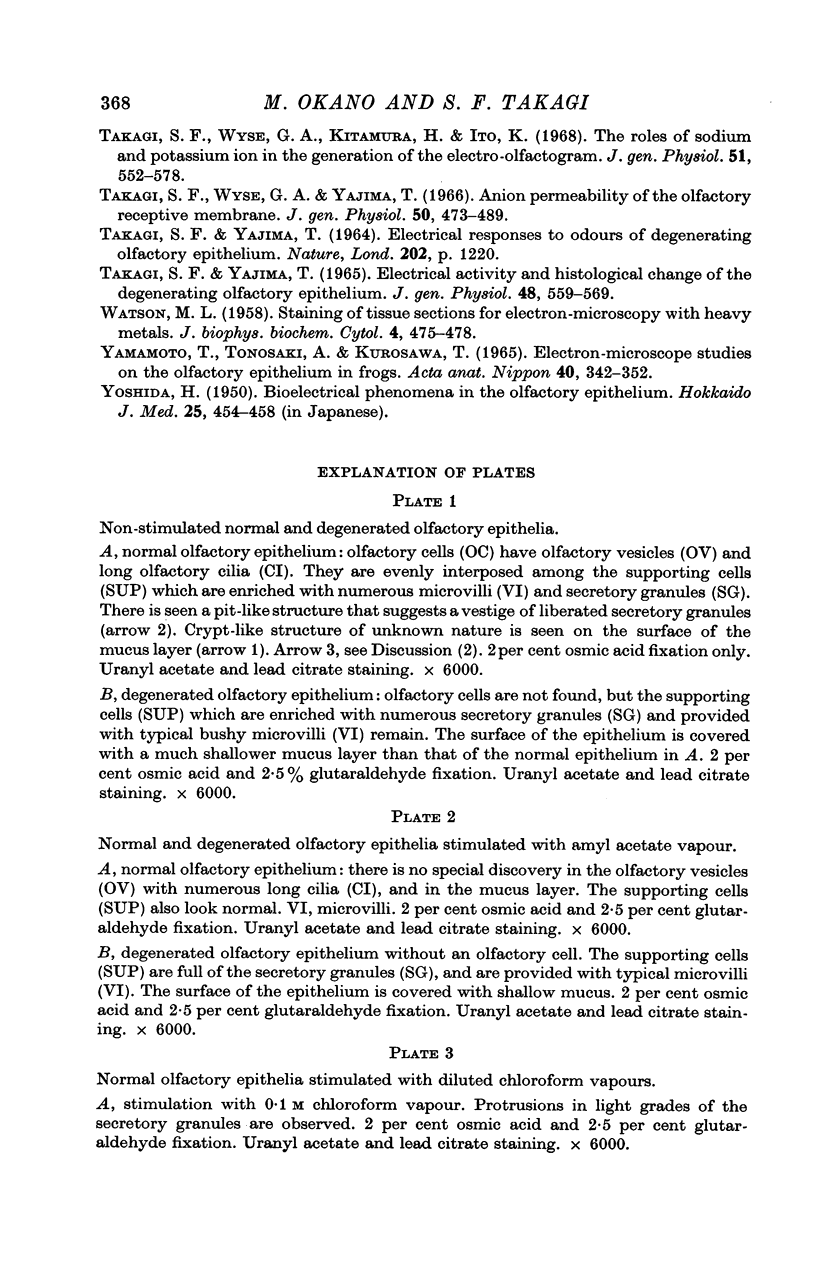
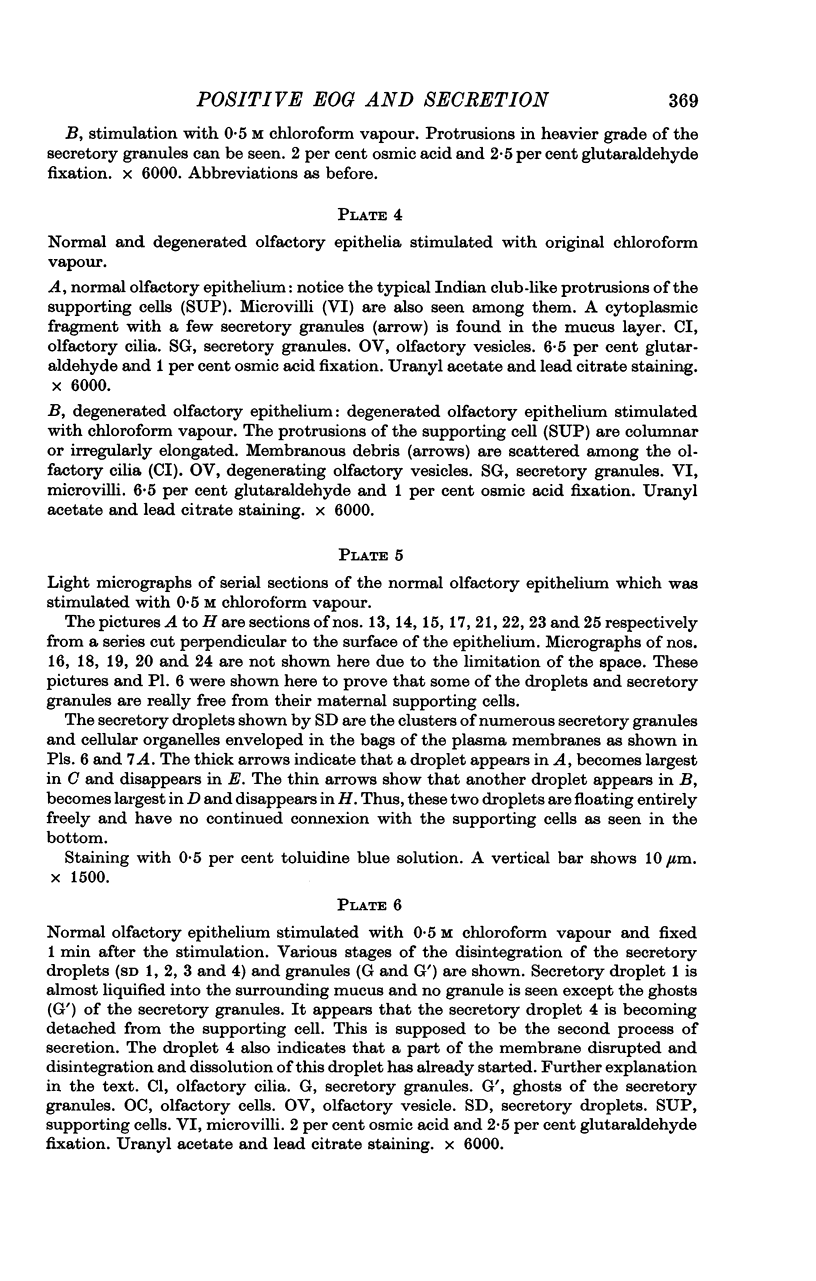




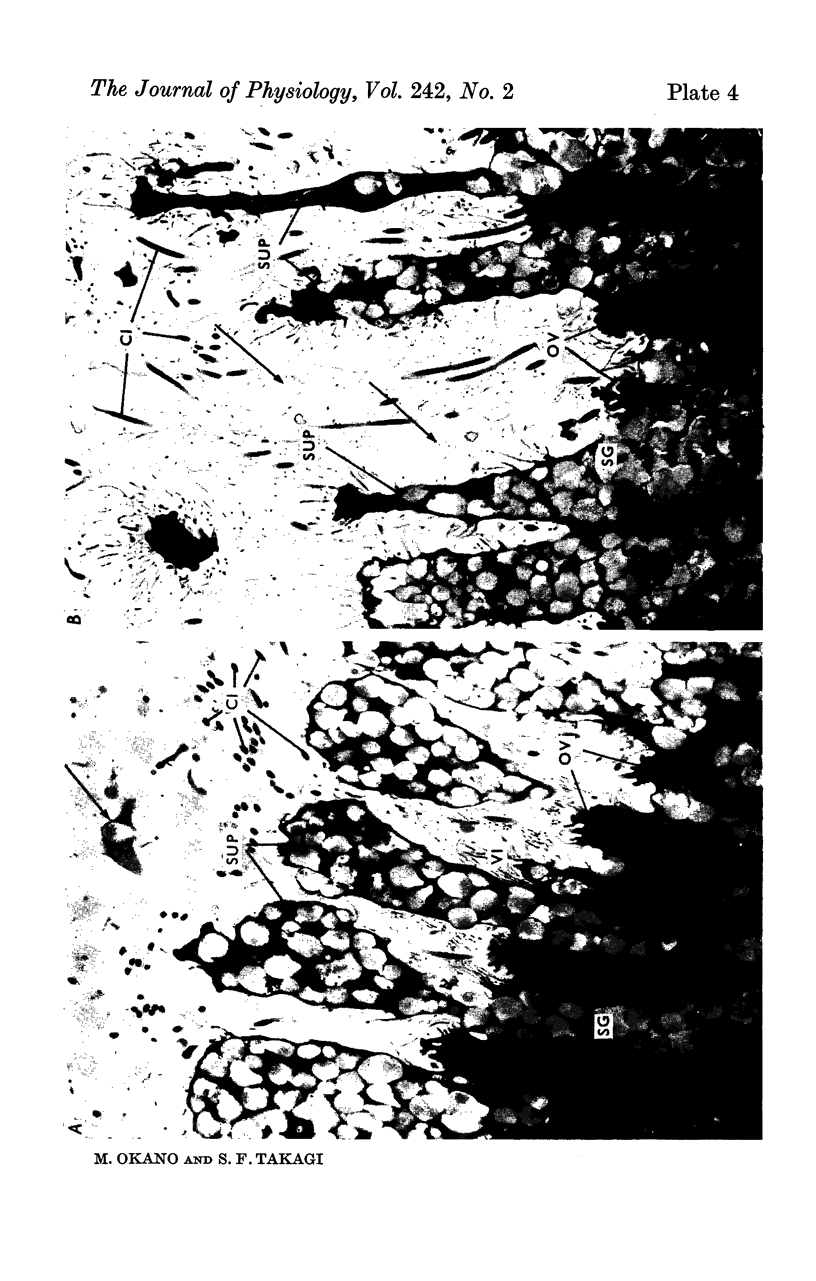
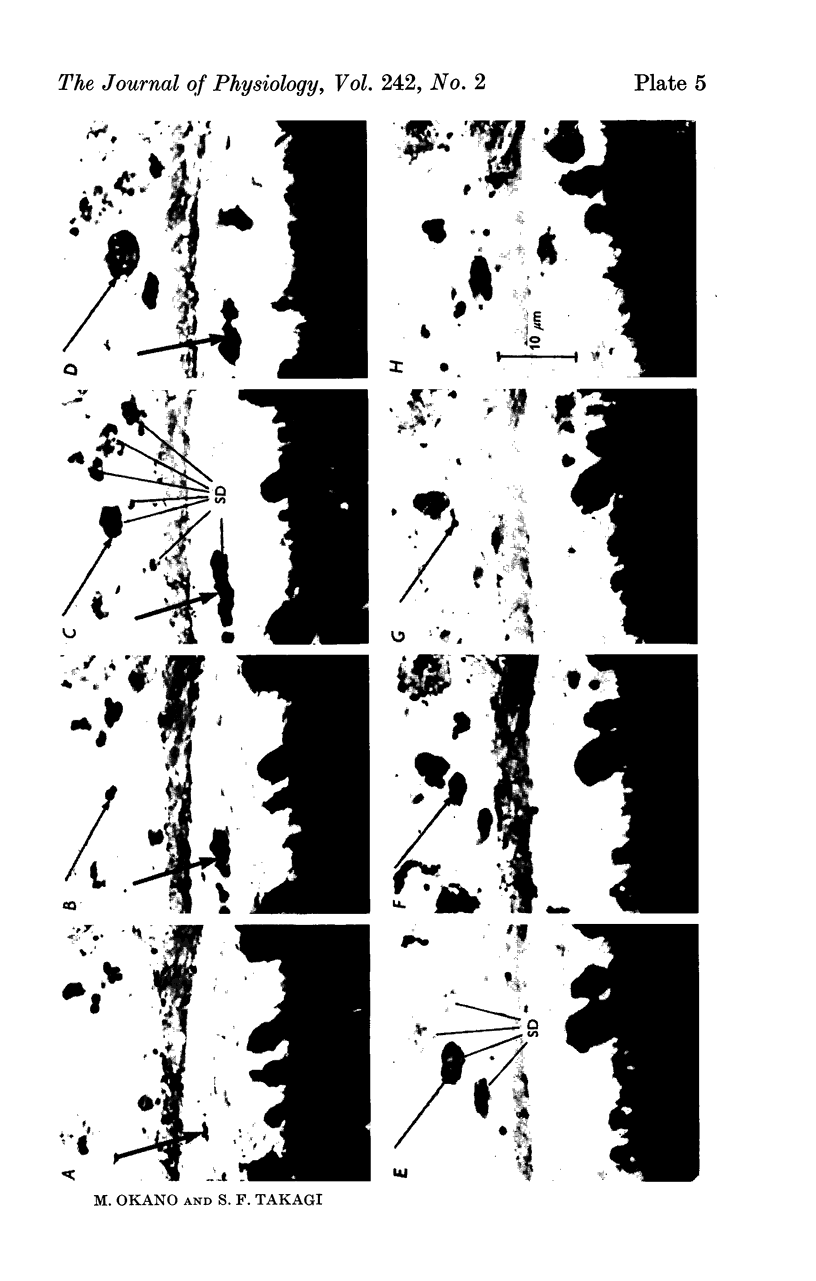

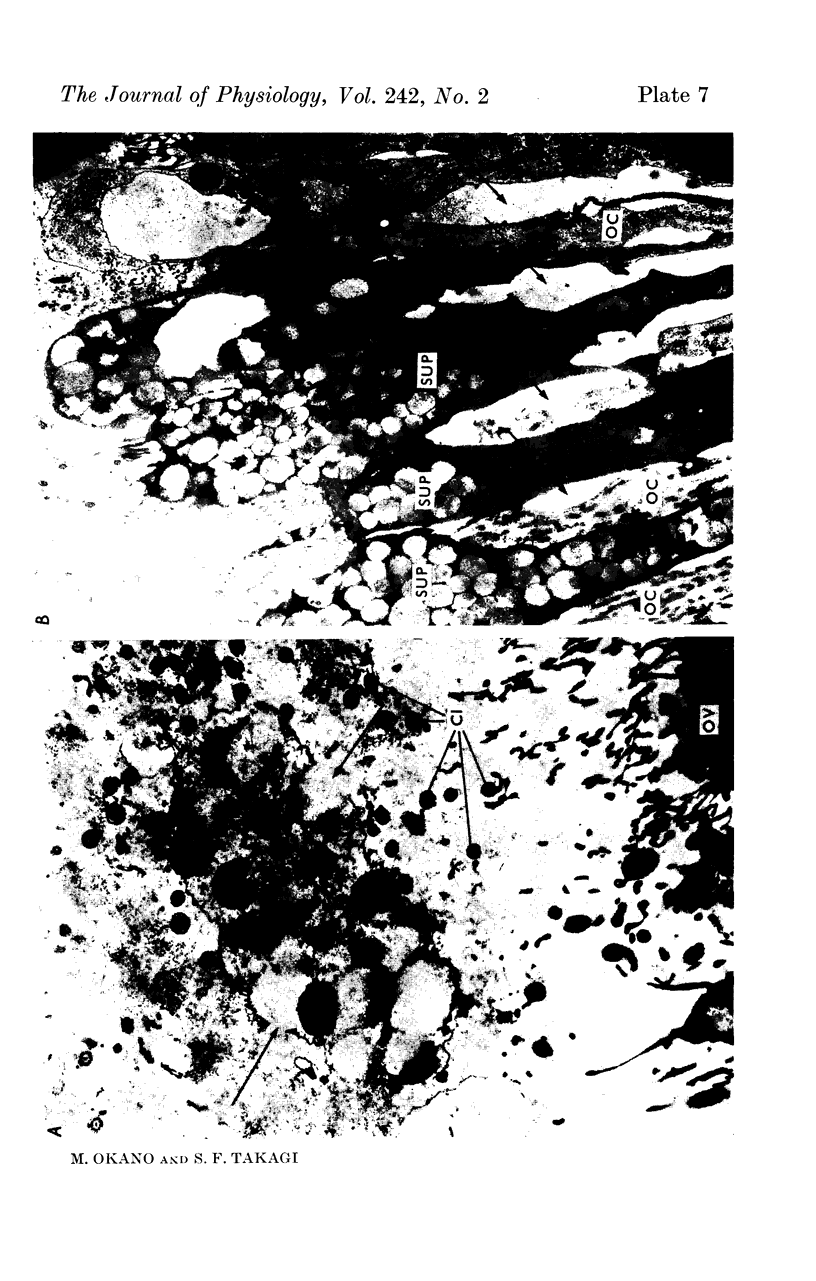

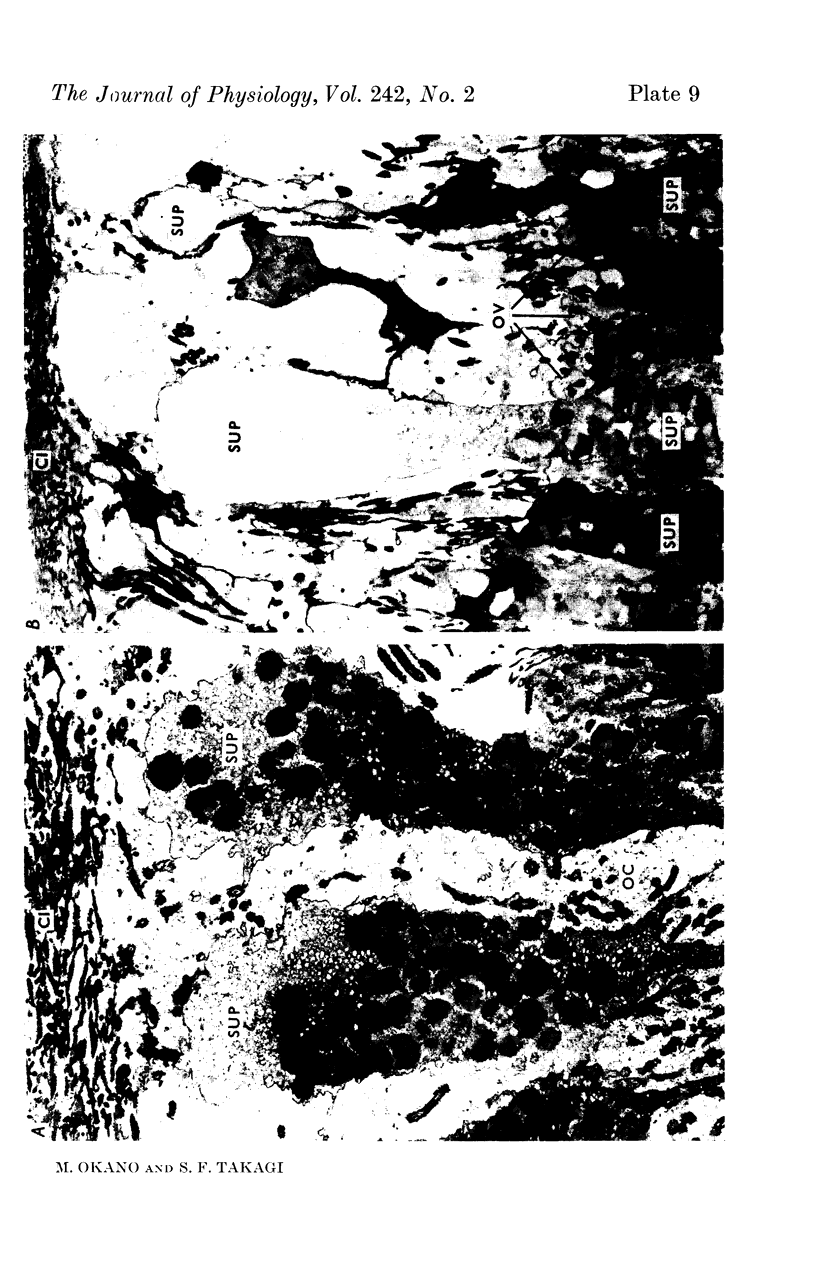
Images in this article
Selected References
These references are in PubMed. This may not be the complete list of references from this article.
- Andres K. H. Der Feinbau der Regio olfactoria von Makrosmatikern. Z Zellforsch Mikrosk Anat. 1966;69:140–154. [PubMed] [Google Scholar]
- Andres K. H. Differenzierung und Regeneration von Sinneszellen in der Regio olfactoria. Naturwissenschaften. 1965 Sep;52(17):500–500. [PubMed] [Google Scholar]
- BLOOM G. Studies on the olfactory epithelium of the frog and the toad with the aid of light and electron microscopy. Z Zellforsch Mikrosk Anat. 1954;41(1):89–100. doi: 10.1007/BF00340285. [DOI] [PubMed] [Google Scholar]
- CAULFIELD J. B. Effects of varying the vehicle for OsO4 in tissue fixation. J Biophys Biochem Cytol. 1957 Sep 25;3(5):827–830. doi: 10.1083/jcb.3.5.827. [DOI] [PMC free article] [PubMed] [Google Scholar]
- CLARK W. L. Inquiries into the anatomical basis of olfactory discrimination. Proc R Soc Lond B Biol Sci. 1957 May 7;146(924):299–319. doi: 10.1098/rspb.1957.0013. [DOI] [PubMed] [Google Scholar]
- Frisch D. Ultrastructure of mouse olfactory mucosa. Am J Anat. 1967 Jul;121(1):87–120. doi: 10.1002/aja.1001210107. [DOI] [PubMed] [Google Scholar]
- Gray E. G., Guillery R. W. Synaptic morphology in the normal and degenerating nervous system. Int Rev Cytol. 1966;19:111–182. doi: 10.1016/s0074-7696(08)60566-5. [DOI] [PubMed] [Google Scholar]
- KUROSUMI K. Electron microscopic analysis of the secretion mechanism. Int Rev Cytol. 1961;11:1–124. doi: 10.1016/s0074-7696(08)62713-8. [DOI] [PubMed] [Google Scholar]
- LUFT J. H. Improvements in epoxy resin embedding methods. J Biophys Biochem Cytol. 1961 Feb;9:409–414. doi: 10.1083/jcb.9.2.409. [DOI] [PMC free article] [PubMed] [Google Scholar]
- LUNDBERG A. Secretory potentials in the sublingual gland of the cat. Acta Physiol Scand. 1957 Sep 17;40(1):21–34. doi: 10.1111/j.1748-1716.1957.tb01475.x. [DOI] [PubMed] [Google Scholar]
- LUNDBERG A. The mechanism of establishment of secretory potentials in sublingual gland cells. Acta Physiol Scand. 1957 Sep 17;40(1):35–58. doi: 10.1111/j.1748-1716.1957.tb01476.x. [DOI] [PubMed] [Google Scholar]
- MACLEOD P. Premières données sur l'électro-olfactogramme du lapin. J Physiol (Paris) 1959 Jan-Feb;51(1):85–92. [PubMed] [Google Scholar]
- MOZELL M. M. Olfactory mucosal and neural responses in the frog. Am J Physiol. 1962 Aug;203:353–358. doi: 10.1152/ajplegacy.1962.203.2.353. [DOI] [PubMed] [Google Scholar]
- Neutra M., Leblond C. P. The Golgi apparatus. Sci Am. 1969 Feb;220(2):100–107. doi: 10.1038/scientificamerican0269-100. [DOI] [PubMed] [Google Scholar]
- OTTOSON D. Analysis of the electrical activity of the olfactory epithelium. Acta Physiol Scand Suppl. 1955;35(122):1–83. [PubMed] [Google Scholar]
- OTTOSON D. Studies on the relationship between olfactory stimulating effectiveness and physico-chemical properties of odorous compounds. Acta Physiol Scand. 1958 Aug 25;43(2):167–181. doi: 10.1111/j.1748-1716.1958.tb01585.x. [DOI] [PubMed] [Google Scholar]
- Okano M., Weber A. F., Frommes S. P. Electron microscopic studies on the distal border of the canine olfactory epithelium. J Ultrastruct Res. 1967 Mar;17(5):487–502. doi: 10.1016/s0022-5320(67)80137-0. [DOI] [PubMed] [Google Scholar]
- REYNOLDS E. S. The use of lead citrate at high pH as an electron-opaque stain in electron microscopy. J Cell Biol. 1963 Apr;17:208–212. doi: 10.1083/jcb.17.1.208. [DOI] [PMC free article] [PubMed] [Google Scholar]
- Reese T. S. OLFACTORY CILIA IN THE FROG. J Cell Biol. 1965 May 1;25(2):209–230. doi: 10.1083/jcb.25.2.209. [DOI] [PMC free article] [PubMed] [Google Scholar]
- SABATINI D. D., BENSCH K., BARRNETT R. J. Cytochemistry and electron microscopy. The preservation of cellular ultrastructure and enzymatic activity by aldehyde fixation. J Cell Biol. 1963 Apr;17:19–58. doi: 10.1083/jcb.17.1.19. [DOI] [PMC free article] [PubMed] [Google Scholar]
- SHIBUYA T. The electrical responses of the olfactory epithelium of some fishes. Jpn J Physiol. 1960 Jun 29;10:317–326. doi: 10.2170/jjphysiol.10.317. [DOI] [PubMed] [Google Scholar]
- Shibuya T. Dissociation of Olfactory Neural Response and Mucosal Potential. Science. 1964 Mar 20;143(3612):1338–1339. doi: 10.1126/science.143.3612.1338. [DOI] [PubMed] [Google Scholar]
- Svaetichin G., Negishi K., Fatehchand R., Drujan B. D., Selvín de Testa A. Nervous function based on interactions between neuronal and non-neuronal elements. Prog Brain Res. 1965;15:243–266. doi: 10.1016/s0079-6123(08)60951-6. [DOI] [PubMed] [Google Scholar]
- TAKAGI S. F., SHIBUYA T. 'On'- and 'Off'-responses of the olfactory epithelium. Nature. 1959 Jul 4;184:60–60. doi: 10.1038/184060a0. [DOI] [PubMed] [Google Scholar]
- TAKAGI S. F., SHIBUYA T., HIGASHINO S., ARAI T. The stimulative and anaesthetic actions of ether on the olfactory epithelium of the frog and the toad. Jpn J Physiol. 1960 Dec 15;10:571–584. doi: 10.2170/jjphysiol.10.571. [DOI] [PubMed] [Google Scholar]
- TAKAGI S. F., SHIBUYA T. The 'on' and 'off' responses observed in the lower olfactory pathway. Jpn J Physiol. 1960 Feb 29;10:99–105. doi: 10.2170/jjphysiol.10.99. [DOI] [PubMed] [Google Scholar]
- TAKAGI S. F., SHIBUYA T. The electrical activity of the olfactory epithelium studied with micro- and macro-electrodes. Jpn J Physiol. 1960 Aug 15;10:385–395. doi: 10.2170/jjphysiol.10.385. [DOI] [PubMed] [Google Scholar]
- TAKAGI S. F., YAJIMA T. ELECTRICAL ACTIVITY AND HISTOLOGICAL CHANGE IN THE DEGENERATING OLFACTORY EPITHELIUM. J Gen Physiol. 1965 Mar;48:559–569. doi: 10.1085/jgp.48.4.559. [DOI] [PMC free article] [PubMed] [Google Scholar]
- TAKAGI S. F., YAJIMA T. ELECTRICAL RESPONSES TO ODOURS OF DEGENERATING OLFACOTRY EPITHELIUM. Nature. 1964 Jun 20;202:1220–1220. doi: 10.1038/2021220a0. [DOI] [PubMed] [Google Scholar]
- Takagi S. F., Wyse G. A., Kitamura H., Ito K. The role of sodium and potassium ions in the generation of the electro-olfactogram. J Gen Physiol. 1968 Apr;51(4):552–578. doi: 10.1085/jgp.51.4.552. [DOI] [PMC free article] [PubMed] [Google Scholar]
- Takagi S. F., Wyse G. A., Yajima T. Anion permeability of the olfactory receptive membrane. J Gen Physiol. 1966 Nov;50(2):473–489. doi: 10.1085/jgp.50.2.473. [DOI] [PMC free article] [PubMed] [Google Scholar]
- WATSON M. L. Staining of tissue sections for electron microscopy with heavy metals. J Biophys Biochem Cytol. 1958 Jul 25;4(4):475–478. doi: 10.1083/jcb.4.4.475. [DOI] [PMC free article] [PubMed] [Google Scholar]





